Gniezno- Greater Poland 作者: 来源: 发布时间:2021-07-15
Ⅰ. Population and Area
Population (2017)
• Total 68,943
Area
• Total 49 km2 (19 sq mi)
Website administrator: wiktor.kolinski@gniezno.eu
Website http://www.Gniezno.eu
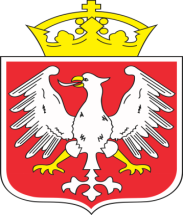
Ⅱ.Natural Geography (environment and resources)
-Gniezno is located in central-western Poland, in the Greater Poland voivodship, 48 km northeast of Poznan. It is at the centre of the Gniezno Lakeland, with a population of over 70,000 and a total urban and suburban area of 40,89 km2.
-Gniezno is situated in the midst of an agricultural area, diversified by moraine hills and periglacial lakes and rivers. There are forests surrounding the town, as well as three relatively small lakes – Winiary (18.6 ha), Jelonek and Swietokrzyskie (Bielidlo). The latter of these lakes attracts a host of water birds.
-Very close to Gniezno is the Lednicki Landscape Park, protecting the most unique elements of the landscape.
Transport
-Nearest Airport to Gniezno, Poland Closest airport to Gniezno is Poznań–Ławica Airport (POZ). Distance from Poznań–Ławica Airport to Gniezno is 32.8 miles / 52.8 kilometers.
-Bus
-Schedule from: 18-09-2020 13:17:14
-Line No. 4.
-From September 21 (Monday) the route and timetable will be changed.
-From Kawiar at 7.20, 8.20 and 9.20. / from Kostrzewski at 13.50, 14.45 and 15.35.
-A new route. Kawiary - Kostrzewskiego, bypassing :ECHowa Street (stops at Leśna Street)and Cymsa stops (stops at Wrzesińska III), Wrzesińska I, II and the viaduct.
-Route: KAWIARY, (section from Alejaierwsza to ul. Grunwaldzka - the route remains unchanged),
-Wrzesińska, Półwiejska, Pustachowska, Wrzesińska, KOSTRZEWSKIEGO.
-Until further notice, on working days, buses run according to the timetable valid on the BUSINESS DAYS OF THE HOLIDAY.
-Additional lines and courses: lines No. 4, 15 and 16 run, line no.10 course at 7.14 from Zdziechowo through Pyszczynek to Dworcowa street, line No. 8 , departure at 7.45 am from Lednicka street
-to Poznańska street through the beltway of Kostrzewskiego street - 0rzeszkowa street, line no. 7.10 from Fabryczna street is moved to 7.20 from Arkuszów II through Wschodnia Street.
-Line no.2 - additional course at 7.13 from Wierzbiczany.
-ATTENTION!! Until further notice:
-Bus no. 14 does not run,
-Exception - departure at 7.47 from Kawiar to the viaduct at Grunwaldzka Street (school).
-Bus no. 7 does not run on SUNDAY and HOLIDAY.
-Closed viaduct.
-Buses no. 3, 9, 11 and 17 run in a transfer mode.
-Stops on the southern side of the viaduct are located near Rondo Olimpijczyki and on the northern side at Dworcowa Street (after the exit from the viaduct).
-L. No. 31 - final and starting stop on the southern side of the viaduct.
-Ticket sales on buses have been suspended until further notice.
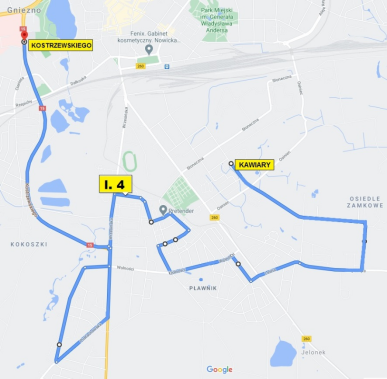
Ⅲ.Economy
-The Kostrzyn-Słubice Special Economic Zone operates in the city of Gniezno, which is one of the fourteen special economic zones in Poland. It was established by a regulation of the Council of Ministers in September 1997 in order to support the economic development of north-western Poland, in particular the Lubuskie Voivodeship. Currently, the zone covers several dozen locations with a total area of over 1800 ha in the areas of the Lubuskie and Zachodniopomorskie voivodeships and the eastern part of the Greater Poland Voivodeship, including the city of Poznań.
-The zone offers areas that are fully prepared for investment commencement. The investor can count on tax reliefs and preferences guaranteed legally by the Polish government and parliament. Tax exemptions in the Kostrzyn-Słubice Special Economic Zone are the largest available financial relief currently in force in Poland. The investor is supported by the government of the Republic of Poland and local governments, which are the main shareholders of the Kostrzyńsko-Słubicka Specjalna Strefa Ekonomiczna SA Thanks to this, the investments are carried out in conditions that are comfortable for the investor, and the efficiency of the company managing the Zone makes it much easier for companies to start and run a business in Poland.
Ⅳ.Industrial Characteristics
-Gniezno, the historic First Capital of Poland, is a medium-sized (approx. 70,000 inhabitants) tourist city with a rich cultural and sports offer - but not only. Lech Castle is also an industrial center with several decades of tradition. In the 19th and 20th centuries, it was the center of the food, processing, machine and light industries.
-Nowadays, the good climate for locating their investments has been appreciated by many companies with Polish and foreign capital: at present, the largest production plants in Gniezno are created by such companies with an international reach, such as:
-Panasonic Battery Poland SA (batteries and accumulators),
-VELUX Group (roof windows at Słoneczna Street, metal fittings and plastic components at Kolejowa Street),
-Trepko Sp. z o. o. (packaging machines),
-Kirchhoff Automotive (car components),
-Scanclimber Sp. z o. o. (hydraulic lifts),
-PHU Best-Pol and Tex Year Europe Sp. with oo (glues)
-Jeremias Sp. z o. o. (chimney systems),
-Tompla Koperty Sp. z o. o. (envelopes),
-Verallia Sp. z o. o. (decorated glass).
- There are many factors that favor investing in Gniezno, the most important of which are:
-good geographic location, including:
-• on the S5 expressway (Gniezno Południe, Kłecko, Gniezno Północ
-junctions ), • near the A2 motorway (Września junction via DK15 - 30 km, Poznań Wschód junction via S5 - 40 km),
-• near international airports: Poznań-Ławica ( POZ) - 60 km, Bydgoszcz-Szwederowo (BZG) - 80 km),
-• along the following railway lines: Wrocław-Poznań-Gniezno-Gdańsk-Olsztyn and Gniezno-Września-Jarocin-Oleśnica,
-• close to many large industrial centers and urban areas - within a radius of only 300 km there are Berlin, Warsaw, Tricity, Wrocław, Upper Silesian Industrial District or Łódź,
-• location in an economically well-developed voivodeship;
-activities in the area of the Kostrzyn-Słubice Special Economic Zone ;
-universities (including PWSZ with an engineering profile);
-technical secondary schools;
-lower labor and living costs compared to large urban centers;
-rich accommodation base;
-location of famous international companies;
-vacant land for single- and multi-family housing;
-good access to schools, hospitals;
-wide cultural offer and many places to spend free time;
-rich business environment infrastructure.
-Gniezno is an award-winning city, among others for supporting investors, creating an entrepreneurial climate and exemplary international cooperation, as well as conscientious implementation of projects financed from European funds and city development:
-• In 2001, Gniezno was awarded the Honorary Flag of Europe by the European Commission for being active in international contacts;
-• in 2002, it was awarded the Fair Play Commune title - Certified Investment Locationawarded by the Polish Chamber of Commerce;
-• in 2006, the Council of Europe awarded the city with the Honorary Badge of the Council of Europe for merits in the fieldEuropean integration and activity in international cooperation;
-• in 2012 for the project entitled "Reclamation of Winiary and Jelonek lakes by phosphorus inactivationin bottom sediments ”from the Life + program received an award from the European Commission for oneof the top 5 projects co-financed by this related programwith environmental protection;
-• in 2014, Gniezno was among the winners of the seventh edition of the competition "Poland becomes more beautiful - 7 Wonders of European Funds ”for the EU project“ Królewskie Gniezno in the heart of Wielkopolska in the "Promotional Product" category ;
-• in 2014, Gniezno received the title of "Leader of Regional Development 2014" awarded cities that promote good management standards and invest in development;
-• in 2015, it received the Minister's award for the implementation of the project "Internet in Gniezno for start"Administration and Digitization;
-• in 2016, it was awarded the "Grounds for a medal" distinction , awarded by the Marshal of the Wielopolskie Voivodeship and the President of the Association of Communes and Poviats of Wielkopolska to the investment areas at ul. Cegielski.
-Town Hall in Gniezno - News https://www.gniezno.eu/wiadomosci/1/temat/996
-Key projects
-1. Communication facilities for residents using the railway station
-The investment of the Wielkopolska Province Roads Authority in Poznań, which is the renovation of the viaduct Fr. Jerzy Popiełuszko is a communication challenge for the entire city. In order to meet this issue, the City Hall in Gniezno, under an appropriate agreement with PKP SA and PKP PLK SA, will provide residents with an additional pedestrian crossing.
-City Hall in Gniezno - Communication facilities for residents using the railway station https://www.gniezno.eu/wiadomosci/1/wiadomosc/180254/ulatwienia_komunikacyjne_dla_mieszkancow_korzystajacych_z_dworca
-2. On August 10, the renovation of the viaduct of Fr. J. Popiełuszko
-One of the largest road investments in recent years is ahead of us. By the decision of the Wielkopolska Province Roads Authority in Poznań, the viaduct of Rev. Jerzy Popiełuszko in Gniezno, located along Warszawska Street on road number 260.
-Urząd Miejski w Gnieźnie - 10 sierpnia rozpoczyna się remont wiaduktu ks. J. Popiełuszki (film) https://www.gniezno.eu/wiadomosci/1/wiadomosc/178174/10_sierpnia_rozpoczyna_sie_remont_wiaduktu_ks_j_popieluszki_film
Ⅴ.Attrations and Cityscape
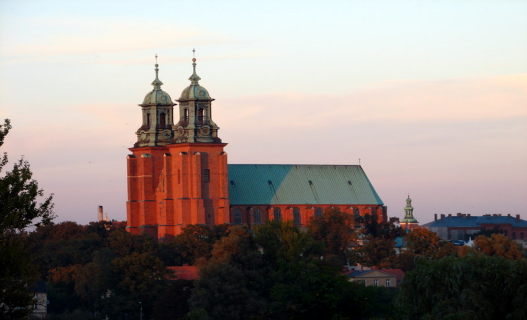
View of Cathedral Basilica of the Assumption of the Blessed Virgin Mary and St. Adalbert. On the right side - church under the invocation of St. John the Baptist

Gniezno Cathedral
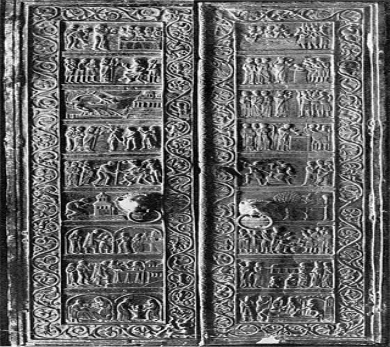
Gniezno Doors in the Cathedral
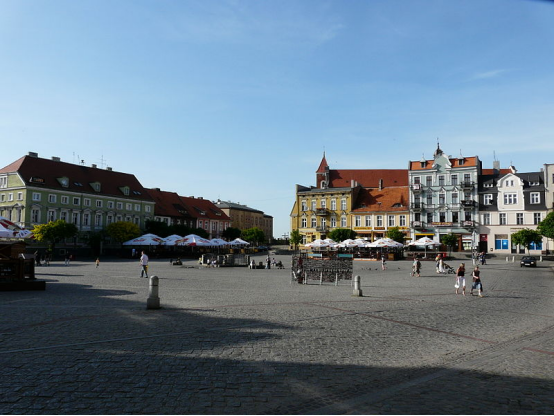
Market Square (Rynek)
-Rated as one of the oldest towns in Poland, Gniezno maintains a unique place on the country’s map. Nearly all of historic buildings within its walls can trace their origins to the earliest period of the Polish state. Recently a number of these buildings have been renovated, helping to revive the visible historic importance of the town in Poland. Gniezno is also recognised as a significant place of worship of Saint Adalbert, the first bishop of Prague.
-The single most unmissable thing to see in Gniezno is the 14th-century Gothic Cathedral, with its priceless memorabilia, relics, and the tomb of Saint Adalbert that draws Catholics from all over Europe. The Cathedral witnessed the coronation of the first five Polish kings, and one can also visit the archive containing several of Poland’s earliest manuscripts.
-There are also several Gothic churches to see in this history-laden town, and the Archdiocesan Museum and the Museum of the Origins of the Polish State are well worth a visit.
-When you weary of museums, galleries and exhibitions, consider a stroll around the tranquil Lake Jelonek, one of the best places to view the splendour of the old town of Gniezno.
-The landmarks of Gniezno include:
-Gothic Gniezno Cathedral, one of the historically most important Polish churches, designated a Historic Monument of Poland; the seat of the Roman Catholic Archdiocese of Gniezno, which is the oldest archdiocese of Poland, founded in 1000. It contains the Gniezno Doors, one of the most important works of Romanesque art in Poland, as well as the coffin of Saint Adalbert of Prague
-Gniezno Old Town, filled with historic townhouses, buildings and churches:
-Gothic-Baroque Holy Trinity church
-Gothic-Baroque Franciscan church and monastery
-Gothic Saint John the Baptist church
-Gothic Saint Lawrence church
-Baroque Saint George church
-Gothic Saint Michael Archangel church
-Museum of the Polish State Origins (Muzeum Początków Państwa Polskiego)
-Museum of Archdiocese of Gniezno (Muzeum Archidiecezjalne w Gnieźnie)
-Monument of King Bolesław I the Brave
Ⅵ.History and Culture
-Gniezno is one of the most important towns in the history of Poland. It was the first capital of the nation, and bore witness to many crucial events during the establishment of the Polish state. Gniezno is also closely entwined with the origins of Christianity in Poland.
-Featuring on Gniezno’s coat of arms is a white eagle on a red background. The tie between the eagle and the town’s history is noted in the 13th century Greater Poland Chronicle. Legend has it that there were three brothers, Lech, Czech and Rus, who while walking through thick woods with their tribes came across a large valley surrounded by hills and lakes. On the highest hill stood an oak tree with the nest of a white eagle. Lech became immediately bewitched by this place and decided to settle there with his people. The town was built on seven hills: Lech, Saint Peter, Saint Laurence, Saint Michael, Panienskie, Krzyzackie and Zninskie. Its original name, Gniezdno, derived from the Polish word “gniazdo”, meaning “nest”.
-In the first half of the 10th century, Gniezno served as the centre of the tribal country populated by the Polanie. Afterwards, once the tribes began to unite, the settlement grew into a capital established by the dynasty of Piasts.
-The most important year in the history of Poland is 966, with the rite of baptism of Prince Mieszko I and the entire nation taking place in Gniezno. From that year on, the town was not just a capital of a newly founded country, but also the centre of a new religion in the region.
-Once the remains of the martyr Saint Adalbert were interred at the Cathedral in 999, Prince Boleslaw Chrobry successfully requested the Pope to found a church metropolis in Gniezno, making it easier for him to become king.
-In the year 1000, the German emperor Otto III made a pilgrimage to Saint Adalbert’s tomb. The coronation of Boleslaw Chrobry took place in the Cathedral in 1025, and soon afterwards his son Mieszko II was crowned King of Poland. Before long, the more secure town of Krakow took over as capital of the state from Gniezno.
-Moving on to a more recent history, in the years 1939-45 different kinds of German terror were unleashed in Gniezno. The town was not destroyed during the liberation in 1945, however the one building that did suffer some damage was the Cathedral.
-In 1994 Gniezno was given the title “Gniezno – the city of St Adalbert”.
Ⅶ.Other Information
-Gniezno is a city in central-western Poland, about 50 kilometres (31 miles) east of Poznań, with 68,943 inhabitants making it the sixth-largest city in the Greater Poland Voivodeship. One of the Piast dynasty's chief cities, it was the first historical capital of Poland in the 10th century and early 11th century, it was mentioned in 10th-century sources, possibly including the Dagome Iudex, as the capital of Piast Poland. The Roman Catholic archbishop of Gniezno is the primate of Poland, making it the country's ecclesiastical capital. It has belonged since 1999 to the Greater Poland Voivodeship, and is the administrative seat of Gniezno County (powiat).
Ⅷ.Contact Information
Mayor Tomasz Budasz
Tel: 61 426 04 00
Fax: 61 426 05 00
E-mail: uwad@gniezno.eu
Website administrator: wiktor.kolinski@gniezno.eu
